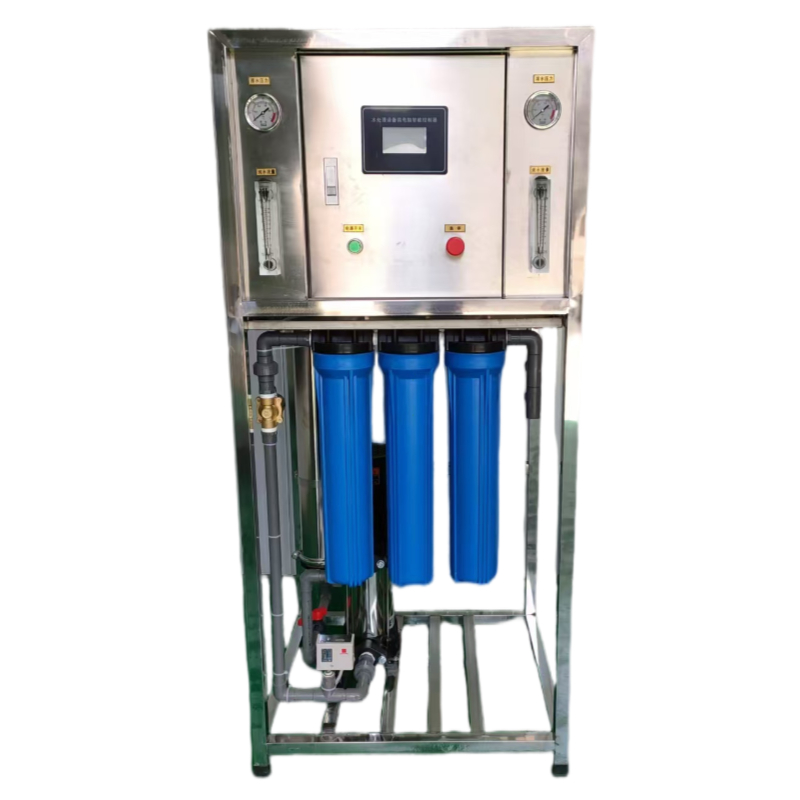
Introduction:
The RO water purifier system adopts the most advanced American RO assembles and with a preset systerm. It enables the water to pass the reverse osmosis film with a diameter of one ten-thousand of a micron and separates impurities, ion, microbes and colloids in the water, so as to meet the water requirements in cosmetics, pharmacy, electronics and food industries.
Working Process:
Water Source---Water Source Tank(customer to get ready)---Pressure Pump---Manganic Sand Filter—Active Carbon Filter—Scale Inhibitor Dosing System ---1st Step Security Filter---2nd Step Security Filter ----3rd Step Security Filter—High Pressure Pump---RO Membrane---Pure Water Tank(customer to get ready)---Transfer Pump(customer to get ready)-----UV-—Precise Filter---Final Water

Reverse Osmosis
Reverse osmosis (RO) is a water purification technology that uses a semipermeable membrane to remove ions, molecules and larger particles from drinking water. In reverse osmosis, an applied pressure is used to overcome osmotic pressure, a colligative property, that is driven by chemical potential differences of the solvent, a thermodynamic parameter. Reverse osmosis can remove many types of dissolved and suspended species from water, including bacteria, and is used in both industrial processes and the production of potable water. The result is that the solute is retained on the pressurized side of the membrane and the pure solvent is allowed to pass to the other side. To be "selective", this membrane should not allow large molecules or ions through the pores (holes), but should allow smaller components of the solution (such as solvent molecules) to pass freely.
What is Reverse Osmosis?
Reverse osmosis (R/O) is a water treatment process in which water is forced through a semi-permeable membrane that has very small holes or "pores". Clean water passes through and impurities that are too big to pass through the membrane are left behind and flushed away. In a word, it is a machine to make pure/ultra pure water.
How Do I Know Which Size Unit to Buy?
General guidelines for modeling an RO system to take into consideration are the silt density index (SDI) measurement of the feed water after pretreatment. Derived from experien- ce, limits on permeate flux and element recovery for different types of waters are based on correlation of the SDI value with membrane fouling and mineral content with element re-covery, respectfully, for different types of waters. These ge- neral limits shown in Table 1 below serve as boundary condi-tions when designing a RO system. A system designed with high permeate flux rates for example is likely to experience higher fouling rates and more frequent chemical cleanings. Due to high salinity (>36,000 ppm TDS), seawater system de-signs are further limited by the osmotic pressure and durabi- lity of the membrane elements.
Material of reverse osmosis system?
We have different material for different application. Before choosing RO System and Type please contact with our Professional technical service.
1.Tanks: Fiber glass or Stainless Steel 304/316
2. Pipes: U-PVC or stainless steel filter
3. Frame: Stainless Steel 304 or 316
4. Filter Housing: U-PVC or SS304 or SS316
5. Memrane Housing: FRP or SS304 or SS316
Of course, every application is unique and we want to make sure you find the exact solution that you are looking for, so reach out to professional and ask all the questions you have to find your industrial water filtration solution
Benefits of Reverse Osmosis (RO) Systems
RO system requires very less energy for its working.
It requires very low maintenance.
The RO system uses an automated technique called cross-flow to clean its clogged membrane.
RO system, when used in water filters, eliminates 98% of the impurities from tap water.
The water produced by RO technology, when supplied to a gas turbine, improves operating efficiency, and increases output by more than 10%.
RO systems are cost-effective, and their price is continually decreasing.
RO systems do not make use of harmful chemicals, hence are used in many power plants.
Feed Source | Top Water | Well Water | Surface Water | Sea Water | |
Feed SDI | <3 | <3 | <5 | <5 | |
Max Element Recovery (%) | 19 | 17 | 15 | 13
| |
Average System Flux (gfd) | 20 | 17 | 13 | 10 | |
Max Feed Flow Rate per Element (gpm) | 2.5" Diameter | 6 | 6 | 6 | 6 |
Max Feed Flow Rate per Element (gpm) | 4" Diameter | 14 | 14 | 14 | 14 |
Max Feed Flow Rate per Element (gpm) | 8" Diameter | 75 | 70 | 55 | 60 |
Min Concantrate Flow Rate per Element (gpm) | 2.5" Diameter | 1 | 1 | 1 | 1 |
Min Concantrate Flow Rate per Element (gpm) | 4" Diameter | 3 | 3 | 3 | 3 |
Min Concantrate Flow Rate per Element (gpm) | 8" Diameter | 14 | 14 | 14 | 14 |
Our Services
1. One-year guarante for the machines;
2. provide machine operation training;
3. provide machine installation;
4. free sparepart available with the machines;
5. after-sale service available at any time;